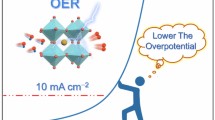Abstract
Surface redox activities, oxygen evolution reaction (OER), oxidation of formic acid (FA), and anodic stability were investigated and compared for IrO2 electrodes prepared by two techniques: the thermal decomposition of H2IrCl6 precursor (TDIROF) and the anodic oxidation of metallic iridium (AIROF). Surface redox activities involved on the AIROF were found to be much faster than those involved on the TDIROF. Concerning the oxygen evolution reaction, both films show a similar mechanism and specific electrocatalytic activities. The situation seems to be different for FA oxidation. In fact, on TDIROF, the oxidation of FA and the OER compete involving the same surface redox couple Ir(VI)/Ir(IV) contrary to FA oxidation on AIROF, where the Ir(V)/Ir(IV) surface redox couple is involved. Finally, electrode stability measurements have shown that contrary to TDIROF, which are very stable under anodic polarization, the AIROF are rapidly corroded under anodic treatment. This corrosion is enhanced even further in the presence of formic acid.








Similar content being viewed by others
References
Trasatti S, O’Grady WE (1981) In: Gerisher H, Tobias CW (eds) Advances in electrochemistry and electrochemical engineering. Wiley, New York, p 177
Comninellis Ch, Nerini A (1995) J Appl Electrochem 25:23
Beck F, Schultz H (1984) Electrochim Acta 29:1569
Trasatti S (2000) Electrochim Acta 45:2377
Beer H, Hinden JM (1985) EU Patent EP 0,046,449 B1
Hinden JM et al (1984) US Patent 4,444,642
Hüppauff M, Lengeler B (1993) J Electrochem Soc 140:598
Silva TM, Simões AMP, Ferreira MGS, Walls M, Da Cunha Belo M (1998) Electroanal Chem 441:5
Jaksic MM, Johansen B, Tunold R (1994) Int J Hydrogen Energy 19:321
Cukman D, Vukovic M (1990) J Electroanal Chem 279:283
Kötz R, Neff H, Stucki S (1984) J Electrochem Soc 131:72
Kötz R (1990) In: Gerischer H, Tobias CW (eds) Advances in electrochemical science and engineering. Verlag Chemie, Heidelberg, p 109
Fierro S, Nagel T, Baltruschat H, Comninellis Ch (2007) Electrochem Commun 9:1969
Fierro S, Nagel T, Baltruschat H, Comninellis Ch (2008) Electrochem Solid-State Lett 11(7):E20
Fierro S, Ouattara L, Herrera Calderon E, Comninellis Ch (2008) Electrochem Commun 10:955
Trasatti S (1980) In: Trasatti S (ed) Studies in physical and theoretical chemistry: electrodes of conductive metallic oxides Part A. Elsevier Scientific Publishing Company, Amsterdam, p 155
De Faria LA, Boodts JFC, Trasatti S (1996) J Appl Electrochem 26:1195
Vukovic M (1990) J Appl Electrochem 20:969
Gottesfeld S, Srinivasan S (1978) J Electroanal Chem 86:89
Fierro S et al (2008) Electrochim Acta. doi: 10.1016/j.electacta.2008.06.060
Acknowledgments
The authors gratefully thank the Fonds National Suisse de la Recherche Scientifique for financial support as well as the Sensors, Actuators and Microsystems Laboratory, Institute of Microtechnology, University of Neuchâtel (SAMLAB-UNINE) for providing the iridium electrodes.
Author information
Authors and Affiliations
Corresponding authors
Rights and permissions
About this article
Cite this article
Ouattara, L., Fierro, S., Frey, O. et al. Electrochemical comparison of IrO2 prepared by anodic oxidation of pure iridium and IrO2 prepared by thermal decomposition of H2IrCl6 precursor solution. J Appl Electrochem 39, 1361–1367 (2009). https://doi.org/10.1007/s10800-009-9809-2
Received:
Accepted:
Published:
Issue Date:
DOI: https://doi.org/10.1007/s10800-009-9809-2




